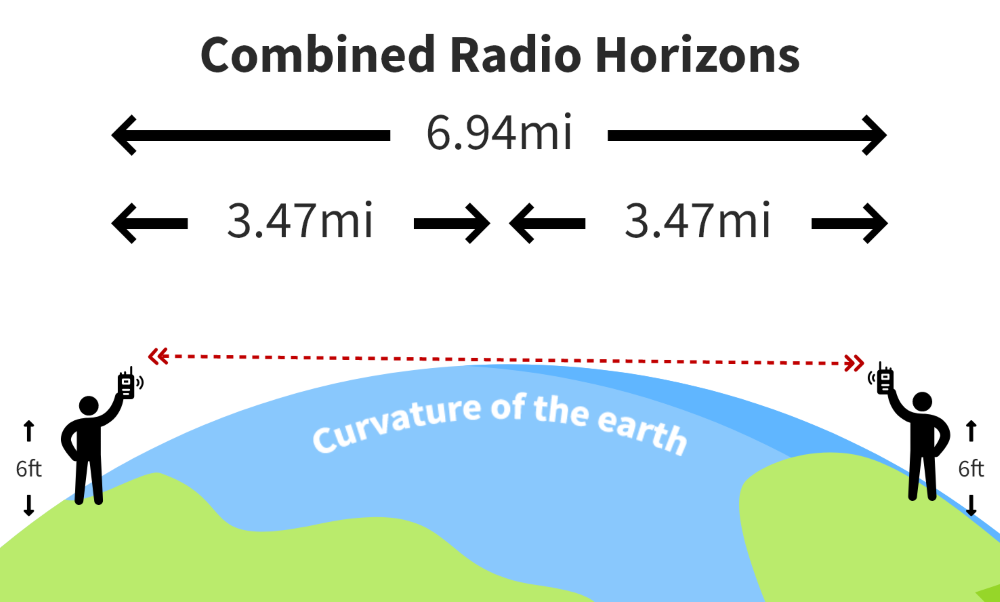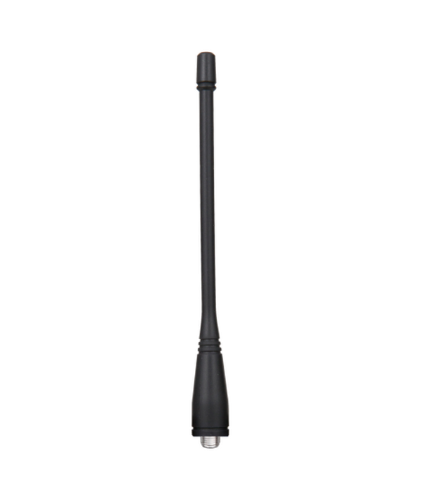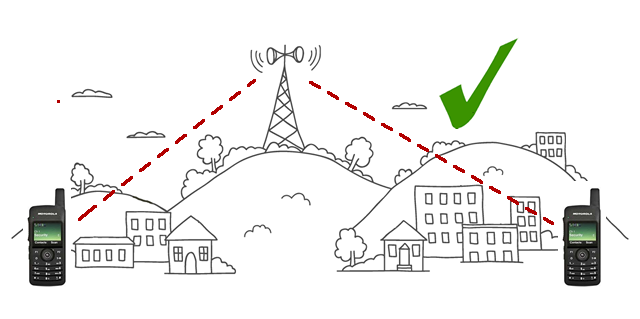What Are PoC / Push-to-Talk Over Cellular Radios?
 13th Dec 2023
13th Dec 2023

 Released On 11th Jul 2024
Released On 11th Jul 2024
In this guide we look at professional solutions for radio communication over greater distances, because a great many people are searching for long-range radios. Lots of customers ask us questions about a radio’s range; our simple explanation will help you understand what’s possible so you can find the best long-range radio solution for your needs.
Our friendly experts are here to help - please get in touch with your queries!
Jump to a specific section:
You’ll often see manufacturers claiming a maximum radio range “up to xx miles”. In reality, only a perfect set of conditions will enable users to achieve the maximum range, whether that’s 5 miles or 50! So the answer is, frustratingly, “It depends”. On what, though?
Even then, some factors, such as terrain and weather, may change each time you use your radio. This means the maximum distance you can transmit and receive may vary from day to day.
Let’s look at each of these factors in more detail.
The most common frequency bands for two-way radios are:
VHF and UHF signals differ in how they travel and how they react to obstacles, which in turn affects how far they can travel.
To begin to understand this, you should know that radio wave frequencies above 2MHz travel in straight lines. This means they travel in a direct line (called line of sight) between the transmitting and receiving antennas. Under normal circumstances, radios with these higher frequencies can’t travel beyond the horizon. To put in another way, the maximum communication distance (without any signal boosters) is an uninterrupted straight line from the radio to the horizon.

Of course, unless you’re at sea, the chances of such an empty landscape to the horizon is very low! There will be buildings, cities, rolling hills or mountains, obstacles that the radio waves have to go through. This is when the different behaviours of VHF and UHF signals affect the long-range capabilities of your radio.
We've written in detail about VHF vs UHF radios in the past, but we’ll also sum up their strengths and weaknesses here:
Taken as a single factor, then, VHF is better for longer distance communication, but don’t rush to buy a VHF two-way radio just yet! Depending on your environment, a UHF model might still be most effective for you.
We’ve just said that VHF wavelengths are better at penetrating objects than UHF, but you should also know that each time any radio signal passes through an object, it gets a little weaker. Particularly dense objects leach more strength from the radio signal, which reduces the distance it can travel, so a radio transmission with fewer obstructions in its path will travel further than one without.
More powerful radios offer some compensation for obstacles that affect the signal’s strength during transmission. A radio’s power output, measured in Watts, affects the strength of the signal when it transmits. A stronger signal can pass through more obstacles without significantly weakening it, so it will travel further.
Most licensed radios (for professional use) are in the range 0.5 Watts to 5 Watts for handheld radios, and up to 25 Watts for marine radios and mobile radios in vehicles or repeater base stations.
UK law limits unlicensed radios (PMR446 walkie talkies) to a maximum of 0.5 Watts, so the maximum distance the signal can travel is much more limited.
Setting aside all other factors that can affect range, here are some examples of the maximum distance that radios with different Wattages could travel:
| Wattage | Range Guidelines |
|---|---|
| 0.5 Watts (licence-free radios) | Up to half a mile |
| 2 Watts | 1 to 2 miles coverage |
| 5 Watts | Up to 6 miles |
| 25 Watts | Up to 10 miles |
Hold your fire, though! Rushing out to buy a 5-Watt handheld radio or a 25-Watt mobile radio won’t necessarily mean you’ll get greater range. We’ll look at the role of the antenna next.
 Antennas can make a significant difference to the distance you can transmit. Without one, in the best possible circumstances, the maximum distance you can communicate is the distance to the horizon. A basic rule of thumb is that higher the antenna, the greater the distance to the horizon, and therefore the greater the radio’s range (all other factors aside).
Antennas can make a significant difference to the distance you can transmit. Without one, in the best possible circumstances, the maximum distance you can communicate is the distance to the horizon. A basic rule of thumb is that higher the antenna, the greater the distance to the horizon, and therefore the greater the radio’s range (all other factors aside).
Antennas for handheld radios
Handheld radios have two types of antenna - stubby and whip. As the name suggests, stubby antennas are short and discreet, so the radio is still small enough to slip unobtrusively into a pocket or clip comfortably to a belt. The downside is that a stubby antenna can reduce your range by up to 30% over whip antennas.
Whip antennas are several inches longer and they’re a better option to boost your communication range.
Antennas for handheld radios are often interchangeable, which is useful if you want to change a stubby antenna for a whip antenna to boost your range.
Antennas for mobile and marine radios
In vehicles, users usually mount mobile radio antennas on the roof or the boot, so they can extend several feet above the height of the vehicle. This extra height helps to considerably extend a radio’s range.
Marine radio antennas tend to be even longer, and mounted higher; the long-range abilities of a marine radio are significant when combined with an open sea and no obstructions to weaken or reflect the signal.

Repeaters are another way to communicate over a longer distance, increase signal penetration, navigate obstructions and improve the clarity of your transmission. They can be used in hilly or very built up areas that obstruct a radio signal, or even over flatter terrain where a greater communication distance weakens the signal.
A repeater is usually installed in a higher location so it has line of sight to all the radios in the system; it receives your radio signal and re-transmits it with increased power.
Repeaters can be complicated to plan and to set up the most effective system, so it’s best to consult with professionals to be sure of a successful installation.

Unless you can boost your signal with antennas or expensive repeater systems, the range of a traditional two-way radio is generally limited to a few miles in most circumstances. However, push-to-talk over cellular radios have almost unlimited range as long as both handsets have mobile data or access to Wi-Fi.
PoC radios have many of the same features of traditional radios plus many of the benefits of cell phones, enabling fast and efficient one-to-one or group communication over vast distances - potentially global - via the 4G / 5G LTE cellular network or Wi-Fi.
PoC radios are known by various other names, including network radios, 4G radios, PTT radios, PoC smartphones, etc.
Learn more about PoC radios and RadioTrader’s PoC platform, Connect Plus to keep your business connected over long distances.
Although PoC radios are gaining in popularity, there are scenarios where they will not help you gain maximum range, or where your organisation can’t risk not having 4G or 5G LTE network coverage. In these circumstances, a wide area radio system - with repeaters - is the preferred option.
Let’s sum it all up. If you already have a two-way radio and you want to maximise its range, or you’re looking to buy a radio where long-distance communication is a priority, here are our top tips and features to look out for:
Looking for radios with reliable, long-distance range? Turn to our experts for free and friendly advice.
 13th Dec 2023
13th Dec 2023
 23rd Aug 2022
23rd Aug 2022
Stay up to date with the latest from RadioTrader